In today’s digital world, every brand, from the most iconic industry giants to nascent startups, is striving to forge deeper and more meaningful connections with their audience. Amidst the cacophony of digital channels, one medium has stood the test of time, proving its resilience and efficacy time and again: email. Crafting a robust and engaged email list isn’t just a mark of prestige; it’s a fundamental tool for sustainable growth. But how does one cultivate such a list in an era saturated with content and choices? Let’s journey together into the world of email list building, unpacking the tools, techniques, and strategies that make it effective.
Why is Email List Building Crucial?
Engagement and Conversion Rates
Email, often viewed as a traditional digital channel, boasts remarkable engagement metrics. According to studies, email marketing has an average open rate of 20-25%, significantly outpacing other forms of digital communication. Moreover, personalized email campaigns can result in transaction rates six times higher than non-personalized campaigns. With such compelling statistics, it’s clear that emails are not just about sending messages; they’re about fostering genuine engagements and catalyzing actions.
We maintain a well-segmented and up-to-date email list, ensuring targeted content delivery for higher engagement rates.
George Smith
Marketing Manager, Infisim
Building a Loyal Subscriber Base
Email is one of the few digital avenues where brands get undivided attention. Regular, value-rich communication with subscribers not only increases brand recall but nurtures a loyal base of advocates and consumers. Unlike fleeting social media updates, emails sit in an inbox, waiting for engagement, offering a brand the opportunity to converse directly with its audience.
ROI of Email Marketing
The power of email marketing shines bright when discussing ROI. For every $1 spent on email marketing, businesses report an average return of $42. Compare this with other marketing channels, and it becomes evident why a robust email list can be a brand’s most prized possession. Building and nurturing this list thus becomes an investment, promising substantial returns in the long run.
To make the most of MailChimp and boost my KPIs, I segment my email lists based on customer behavior and preferences to deliver personalized content, significantly improving open rates and engagement. I also leverage A/B testing for subject lines, content, and call-to-action buttons to determine the most effective elements for conversion. This data-driven approach helps refine my strategies continually.
Marcus Clarke
Founder- Searchant.co
Foundational Elements for List Building
Value Proposition
The digital landscape is bustling with brands vying for consumer attention. So, why should someone subscribe to your emails? This answer lies in a compelling value proposition.
- Crafting Compelling Reasons for People to Subscribe: Whether it’s exclusive offers, insightful content, or early access to products, what you offer should resonate with the needs and aspirations of your audience. For instance, a beauty brand might offer expert beauty tips, while a tech startup could provide industry insights.
- Examples of Strong Value Propositions: Consider Dropbox’s referral program, where both the referrer and the referee got additional storage space. Or the simple, yet effective approach of many e-commerce businesses offering discounts to first-time subscribers. Such value propositions cater directly to user needs, ensuring a higher likelihood of sign-ups.
Trustworthiness
In an age rife with data breaches and misuse, trust is paramount.
- Importance of Transparency: Assure your subscribers that their data is in safe hands. Clearly communicate your data usage policies and ensure you’re only asking for information you genuinely need.
- GDPR and Data Protection Considerations: With regulations like GDPR in place, it’s not just about building trust but also about legal compliance. Ensure that your email list building practices align with data protection laws, including explicit consent and easy unsubscription options.
Accessibility
In the quest to grow an email list, ensuring accessibility is vital.
- Making It Easy and Intuitive to Subscribe: Your sign-up form should be easily accessible, not tucked away in some obscure corner of your website. Consider multiple touchpoints – headers, footers, or even as part of blog articles.
- Importance of Mobile Optimization: Over 50% of emails are now opened on mobile devices. If your subscription forms aren’t mobile-optimized, you’re potentially turning away a significant chunk of your audience.
Strategies for Email List Building
#1. Lead Capture Forms
These are the frontline soldiers in your list-building arsenal. They capture the necessary information and should be strategically placed to attract potential subscribers.
- Tools like OptinMonster, Sumo, Thrive Leads: Platforms like OptinMonster offer advanced targeting and segmentation, enabling brands to show the right message to the right people at the right time.
- Best Practices in Form Design and Placement: Keep forms concise, often limiting to just an email address and maybe a name. Use engaging CTAs like “Get Started” or “Join the Revolution” instead of the generic “Sign Up”.
Significantly we use MailChimp for developing our email newsletters, handling our email lists, automated email sending, segmentations and tracking email campaigns.
Julian Fernau
CEO & Marketing Expert- FluidFreeRide
#2. Landing Page Builders
Dedicated landing pages can hyper-focus on the subscription goal, devoid of other distractions.
- Platforms like Unbounce, Leadpages, ClickFunnels: These platforms allow brands to design high-converting landing pages without requiring extensive tech expertise.
- Crafting High-converting Landing Pages: Your landing pages should be visually appealing, have a compelling CTA, and reiterate the value proposition to encourage sign-ups.
I create landing pages and forms with Mailchimp to capture leads and grow my email list. I also use Mailchimp’s integrations with social media platforms like Facebook and Instagram to promote my services and generate more traffic to my website.
Cam Dowski
Founder- WeBuyHousesChicago
#3. Pop-ups and Slide-ins
When used judiciously, these can significantly boost subscription rates.
- Balancing Engagement with User Experience: While they’re effective, it’s vital to ensure they don’t hamper the user experience. Timing is crucial – perhaps trigger a pop-up when a user has spent a certain amount of time on your site or is about to exit.
- Tools and Plugins: Tools like Sumo and Hello Bar can help create these pop-ups, offering features like A/B testing to ascertain what works best.
Zoho Campaigns does just as well as any other for segmenting broadcasting, and it also has the ability to slide perfectly into our high-ticket sales pipeline, when the touch point with every prospect affects whether you close a deal or not.
Morgan Gist MacDonald,
Founder and Chief Executive Officer- Paper Raven Books
#4. Referral and Affiliate Systems
Empower your current subscribers to be your brand ambassadors.
- Platforms like ReferralCandy and Ambassador: Such platforms enable brands to set up referral programs where subscribers can earn rewards for bringing in more subscribers.
- Encouraging Subscribers to Bring More Subscribers: Offer incentives that are both appealing to the referrer and the referee. This can exponentially amplify list growth by tapping into the networks of your existing subscribers.
#5. Content Upgrades
Leveraging the content you already produce can be a potent strategy for increasing your email subscribers.
- Offering Bonus Content in Exchange for an Email: Imagine someone reads your article on “10 Ways to Improve SEO”. At the end, you offer a downloadable checklist or an in-depth guide on one particular SEO strategy. This is a content upgrade. It’s immediately relevant and offers added value.
- Ideas: eBooks, exclusive articles, in-depth tutorials, templates, and checklists are all popular forms of content upgrades that can entice readers to part with their email address.
#6. Webinars and Virtual Events
Harness the power of real-time engagement and expertise.
- Harnessing Sign-ups through Informational Sessions: Webinars or virtual workshops on topics relevant to your audience not only establish your brand’s authority but also capture emails during the registration process.
#7. Social Media Campaigns
Your audience on social platforms can be directed to join your email list.
- Cross-promotion on Platforms: Share your content upgrades, webinar invites, or just the direct benefits of joining your email list on platforms like Facebook, Twitter, and LinkedIn.
- Using Ads to Promote Sign-ups: Platforms like Facebook allow you to create ads specifically targeting email sign-ups. Pair this with a strong value proposition, and you’re on your way to growing your list.
#8. Contests and Giveaways
Who doesn’t love free stuff?
- Ensuring Relevance to Attract the Right Audience: A giveaway of the latest iPhone might get you thousands of sign-ups, but are they your target audience? Instead, offer something relevant to your brand and audience. For a fitness brand, it could be a free month’s supply of supplements or workout gear.
- Tools for Organizing and Promoting Contests: Platforms like Rafflecopter or Gleam.io can help streamline the contest process and ensure it’s easy for participants to join, share, and promote.
#9. Seamless Synchronization
- Tools that Directly Integrate with Popular ESPs: Many list-building tools come with direct integrations for popular email platforms like Mailchimp, ConvertKit, or SendinBlue. This ensures that your newly acquired subscribers are instantly added to your main email database.
Segmenting New Subscribers
- Directing New Sign-ups into Relevant Email Sequences: Not all subscribers are created equal. Someone who joined from a webinar might be more advanced than someone who signed up for a beginner’s guide. Segment them accordingly to send tailored content.
Divide your email list into smaller segments. This is based on demographics, behaviors, or preferences. This allows you to send targeted and relevant content to different groups. This leads to higher engagement and conversions.
Neha Gharpande
Digital Marketing Professional- Arista Systems
#10. Automation for Welcome Sequences
- Creating a Positive Onboarding Experience for New Subscribers: Your newest subscribers are among your most engaged. Capitalize on this with an automated welcome email sequence that introduces them to your brand, sets expectations, and provides immediate value.
Tools and Platforms for Email List Building
#1. OptinMonster

Features:
OptinMonster is an online lead generation software that provides marketers with the functionality to create and integrate highly effective email signup forms to their websites. Features include:
- Drag-and-drop form builder.
- A/B testing to identify which forms are more effective.
- Exit-Intent technology, which detects when visitors are about to leave your site and pops up a subscription form.
- Mobile-specific pop-up forms.
- Targeting and segmentation capabilities.
Pricing:
OptinMonster has multiple pricing tiers starting from $9 per month for basic features. The more advanced features become available in the higher tiers.
Pros:
- User-friendly interface.
- Can integrate with all major email marketing platforms.
- Effective Exit-Intent technology.
Cons:
- Some advanced features are only available in higher pricing tiers.
- Customizations might feel limited for more advanced users.#
#2. Sumo
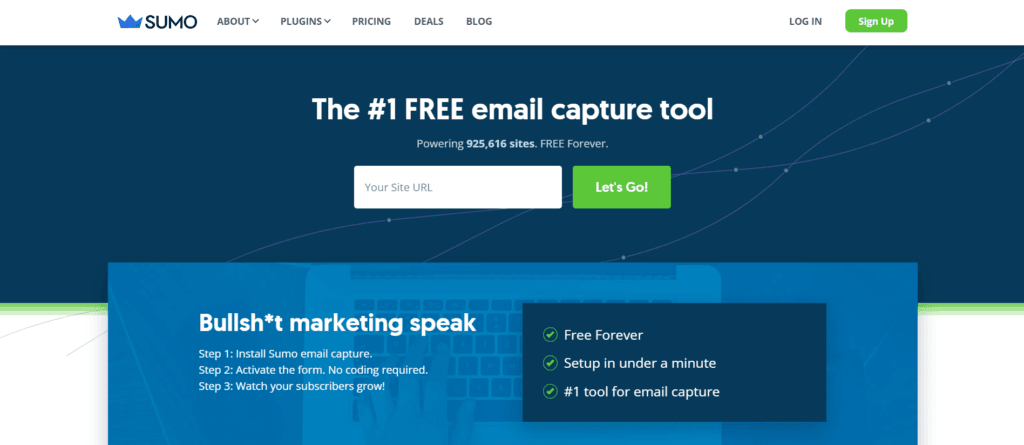
Features:
Sumo offers a suite of tools designed to automate website growth. For email list building:
- List Builder to convert one-time visitors into lifelong readers.
- Welcome Mats that display full-screen call-to-actions.
- Scroll box, a polite way to ask visitors for their email as they scroll through your content.
Pricing:
Sumo offers a free plan, but the Pro version starts at $39 per month.
Pros:
- Offers a suite of tools beyond just email list building.
- Free version available with basic features.
Cons:
- More expensive than some other options.
- The free version has branded pop-ups.
#3. Thrive Themes
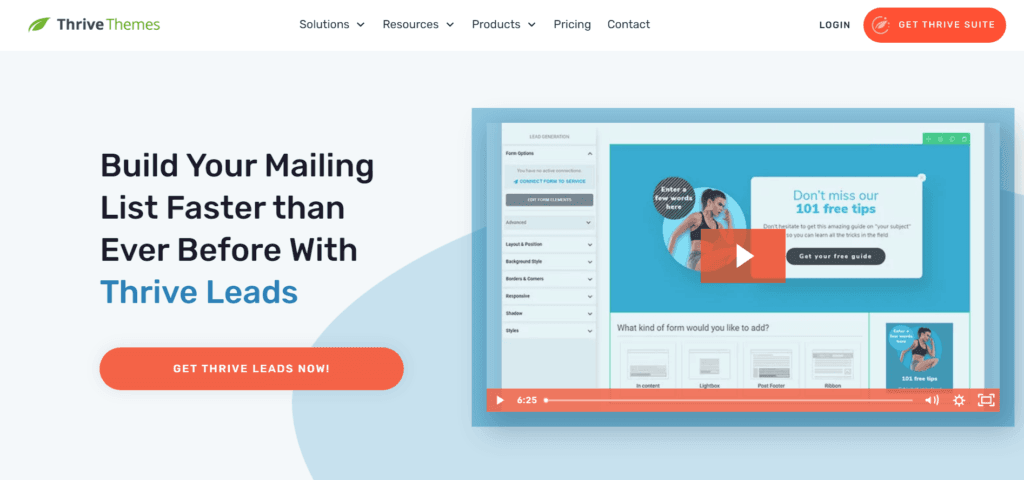
Features:
Thrive Leads is a WordPress plugin that provides an all-in-one list-building solution.
- Drag-and-drop editor for designing opt-in forms.
- Advanced targeting for displaying relevant opt-in forms to specific groups of visitors.
- A/B testing for forms and offers.
Pricing:
Prices start from a one-time fee of $67.
Pros:
- One-time fee instead of monthly.
- Seamless integration with WordPress.
Cons:
- Only available for WordPress websites.
- Might be overkill for those who need a simple solution.
#4. ConvertKit

Features:
ConvertKit is primarily an email service provider but has powerful list-building tools.
- Easy-to-embed, customizable opt-in forms.
- Landing page builder.
- Subscriber tagging and segmentation.
Pricing:
Prices start from $29 per month for up to 1,000 subscribers.
Pros:
- Excellent for those already using ConvertKit for email marketing.
- User-friendly with great support.
Cons:
- Slightly more expensive for beginners.
- Focused more on email marketing, so some list-building features may lack depth.
#5. Hello Bar
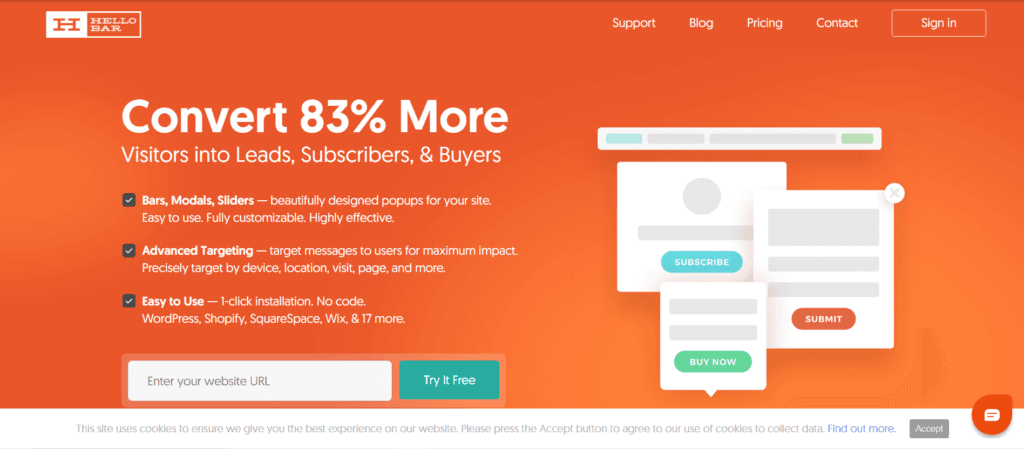
Features:
Hello Bar is a tool designed to capture website visitors’ attention and encourage them to take action, like joining an email list.
- Pop-ups, sliders, and floating bars.
- A/B testing.
- Exit-intent technology.
Pricing:
Free for up to 5,000 views per month, with premium plans starting at $29 per month.
Pros:
- Variety of form types.
- Free plan available for smaller websites.
Cons:
- Some features, like removal of branding, are available only in higher plans.
- Can feel slightly intrusive if overused.
#6. Leadpages
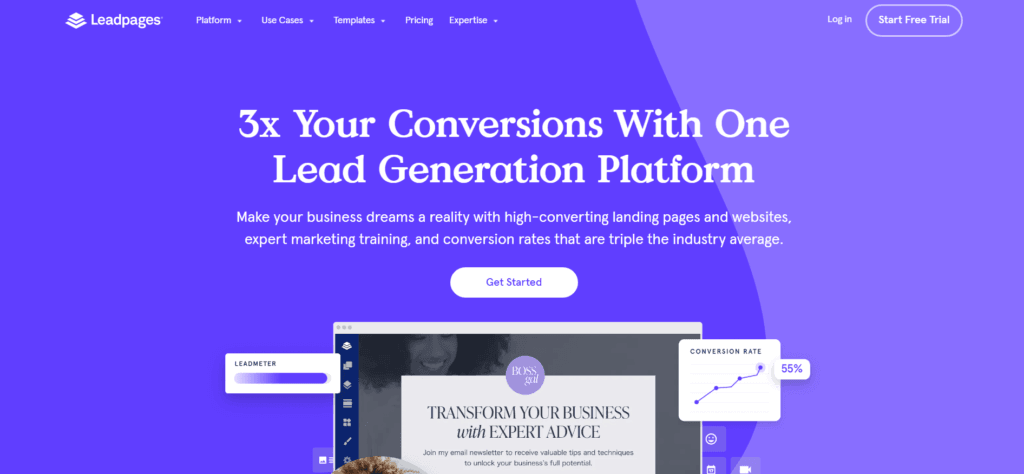
Features:
Leadpages helps small businesses connect with an audience, collect leads, and close sales. It’s not just for building email lists, but it excels at it.
- Drag-and-drop builder.
- High-converting templates.
- A/B testing.
Pricing:
Prices start from $27 per month for the Standard plan.
Pros:
- Multiple tools in one, from landing pages to pop-up forms.
- Integrates with many email marketing platforms.
Cons:
- Slightly more expensive than standalone list-building tools.
- Some features are limited to higher-tier plans.
#7. MailerLite
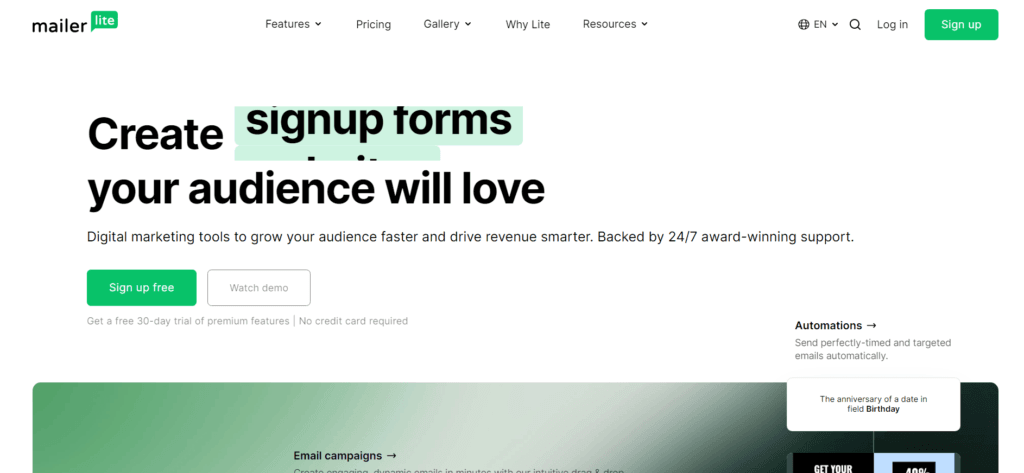
Features:
MailerLite is more than just an email marketing tool; it offers robust features for list building:
- Pop-up forms and landing page builders.
- Drag-and-drop editor for creating compelling subscription forms.
- Integrated surveys and quizzes for engaging potential subscribers.
- Subscriber tagging and segmentation.
Pricing:
It offers a free plan for up to 1,000 subscribers. Premium plans start at $10 per month.
Pros:
- Comprehensive suite of tools for both email marketing and list building.
- User-friendly interface suitable for beginners.
Cons:
- Advanced automation is limited to premium plans.
- Limited integrations compared to other platforms.
#8. SendinBlue
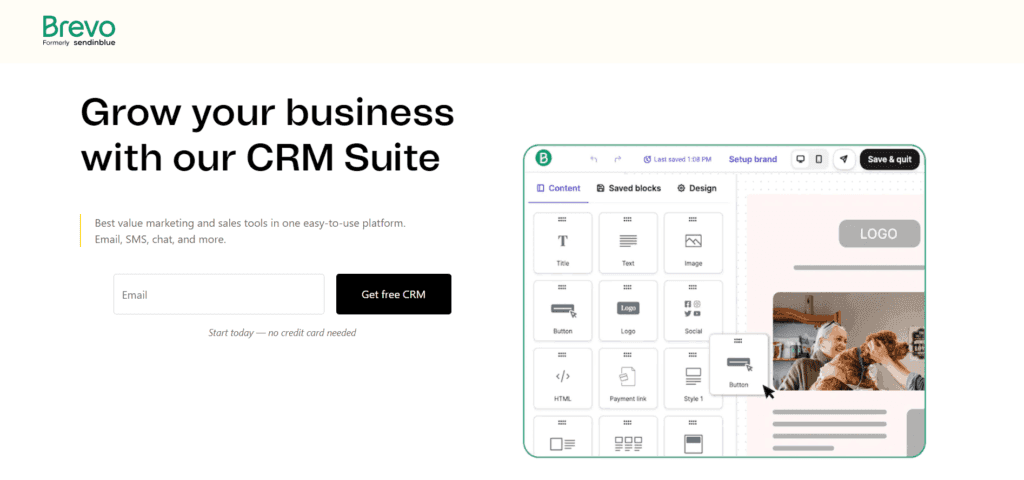
Features:
While SendinBlue is primarily an email marketing and SMS campaign tool, it does offer potent list-building features:
- Customizable sign-up forms.
- Landing page builders.
- Advanced segmentation based on user behavior and demographics.
Pricing:
Free plan available with limited features. Premium plans start at $25 per month.
Pros:
- Combines email marketing, SMS campaigns, and list building.
- Great reporting and analytics.
Cons:
- The free plan has SendinBlue branding on emails.
- Some users find the interface a bit clunky.
#9. Popup Builder

Features:
Popup Builder is a WordPress plugin designed to help you create and deploy various types of popups.
- A plethora of popup designs including lightbox, image, countdown, and more.
- Compatibility with major email marketing tools.
- Options for when and where popups should appear.
Pricing:
Basic plugin is free. Premium features have different pricing, starting at $14.95 for individual add-ons.
Pros:
- Highly customizable with a variety of designs.
- Seamless WordPress integration.
Cons:
- Only available for WordPress.
- Premium features can become expensive.
#10. Bloom by Elegant Themes

Features:
Bloom is an email opt-in and lead generation plugin for WordPress.
- Over 100 customizable templates.
- Trigger options such as timed delay, after purchasing, and after commenting.
- Targeted display settings.
Pricing:
Included with the Elegant Themes membership, which is $89 per year.
Pros:
- Large variety of design options.
- In-depth targeting features.
Cons:
- Only available for WordPress users.
- Can’t purchase it standalone; you must have an Elegant Themes membership.
#11. GetResponse

Features:
GetResponse is an all-in-one marketing platform but has a dedicated suite for list-building.
- Landing page builder with hundreds of templates.
- Webinars platform which can be a unique way to grow an email list.
- A/B testing for opt-in forms.
Pricing:
Pricing starts at $15 per month for the Basic plan.
Pros:
- Wide variety of tools beyond just list-building.
- User-friendly with a drag-and-drop editor.
Cons:
- Some features like webinars are available only in higher-tier plans.
- The interface might be overwhelming for beginners.
#12. Privy

Features:
Privy is designed specifically for eCommerce businesses:
- Pop-ups, flyouts, spin-to-win wheels, and banners for lead capture.
- Integration with eCommerce platforms like Shopify and BigCommerce.
- A/B testing for campaigns.
- Cart abandonment saver feature.
Pricing:
Offers a free plan with basic features. Paid plans start at $15 per month.
Pros:
- eCommerce-centric features for higher conversions.
- Easy integration with popular eCommerce platforms.
Cons:
- Pricing can escalate based on pageviews.
- Limited customization in the free plan.
#13. MailMunch
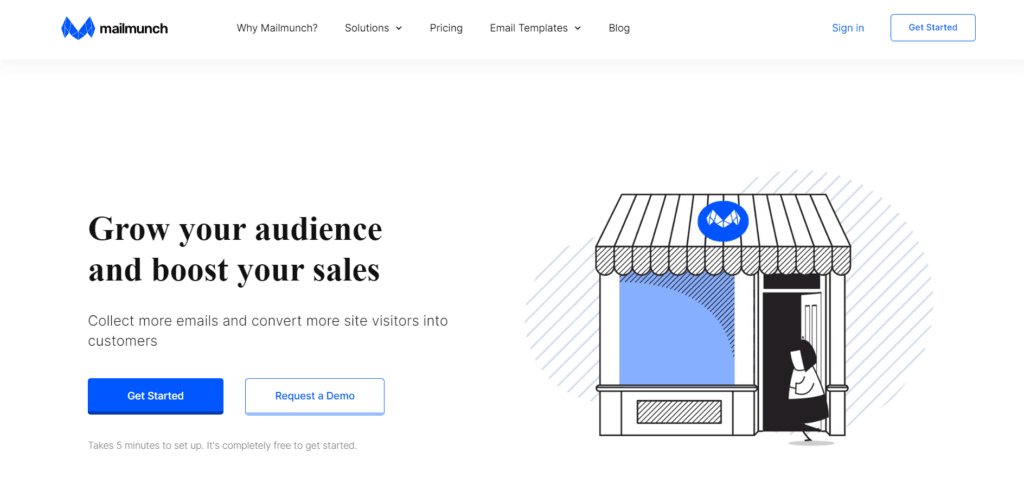
Features:
MailMunch provides tools to grow email subscribers:
- Multiple form types including pop-ups, top bars, and embedded forms.
- Beautiful templates with customization.
- A/B testing and analytics.
- Integrates with popular email marketing platforms.
Pricing:
Has a free basic plan. Premium plans start at $6.99 per month.
Pros:
- Provides a standalone landing page builder.
- Mobile responsive forms for optimal viewing on devices.
Cons:
- Certain templates and customization options are behind paywalls.
- Advanced analytics are available only in higher-tier plans.
#14. GetSiteControl

Features:
GetSiteControl offers a range of widgets for site engagement, including email capture:
- Surveys, pop-ups, floating bars, and slide-ins.
- Targeting options based on behavior, time, or exit intent.
- Integrations with popular email marketing tools.
- Real-time statistics.
Pricing:
Offers a free version. Paid plans start at $19 per month.
Pros:
- All-in-one tool for engagement, not just email capture.
- Easy setup and customization.
Cons:
- Branding is present in the free version.
- Some features might require technical knowledge.
#15. Convertful
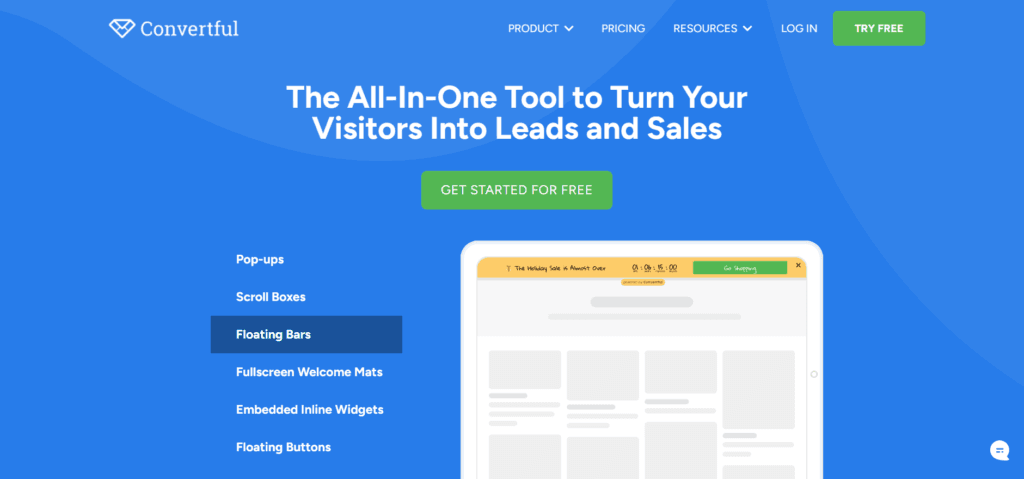
Features:
Convertful offers interactive widgets to engage visitors:
- Spin-to-win gamified opt-ins.
- Quizzes, polls, and surveys for engagement.
- Integration with popular email platforms.
- Segmentation based on visitor behavior.
Pricing:
Has a free plan. Premium plans start from $9 per month.
Pros:
- Variety of interactive tools to capture emails.
- Easy integration and setup process.
Cons:
- Advanced customization requires knowledge of CSS.
- Some advanced features are reserved for top-tier plans.
Best Practices in Email List Maintenance
Building a list is just the start. Keeping it in prime condition ensures maximum ROI.
#1. Regular Cleaning
- Removing Inactive Subscribers: It might sound counter-intuitive, but a smaller, more engaged list can often outperform a larger, disengaged one. Tools like ZeroBounce or Clean Email can help identify and remove inactive subscribers.
- Tools for Identifying and Cleaning Your List: Regularly assess who’s engaging with your emails and who’s not. This not only improves your engagement rates but also reduces the risk of being marked as spam.
#2. Segmentation and Personalization
- Organizing Your List for More Targeted Messaging: If you know a segment of your list is particularly interested in a topic, why not send them more of what they love? Tools within ESPs often allow for detailed segmentation based on behavior, preferences, and more.
Segment your email list based on demographics, preferences, and behavior. This enables you to deliver personalized content that resonates with each segment
Samuel Thomas
Marketing Manager, Instalinko
#3. Feedback Collection
- Periodic Surveys to Understand Subscriber Preferences: It’s simple – ask your audience what they want, then give it to them. Tools like Typeform or SurveyMonkey can help glean these insights.
Avoiding Common Pitfalls
While the road to email list building is paved with opportunities, it’s also strewn with potential pitfalls. Being aware of these can save time, money, and reputation.
#1. Buying Email Lists
It’s an open secret: there are lists out there, ready for purchase. However, the costs often far outweigh the benefits.
- The Dangers of Purchased Lists: Not only are these lists filled with disengaged (or even fake) emails, but they also haven’t granted you permission. This could lead to higher spam rates, tarnished brand reputation, and even legal consequences.
- Inefficacies of Purchased Lists: A list bought, not earned, will almost always have significantly lower engagement rates. Your messages might fall on deaf ears, or worse, lead to increased unsubscribe and spam complaint rates.
I segment my email list based on the type of service they are interested in, such as interior design, home buying, or home selling. This way, I can send them relevant and personalized content that matches their needs and preferences.
Parvinder Singh
CEO & Founder- The Macios
#2. Overloading with Pop-ups
While pop-ups can be effective, there’s a fine line between encouragement and annoyance.
- Striking a Balance: Too many pop-ups can repel potential subscribers. The key is to use them judiciously, ensuring they offer real value and aren’t overly intrusive.
- User Experience is Paramount: Prioritize the user experience. Delayed pop-ups (those that appear after a visitor has been on-site for a set time) or exit-intent pop-ups (triggered when someone is about to leave) can be less intrusive.
#3. Neglecting Mobile Users
With a significant chunk of web traffic and email opens coming from mobile devices, this is a segment you can’t afford to ignore.
- Ensuring All Tools and Techniques are Mobile-friendly: Whether it’s a sign-up form or a landing page, ensure it’s optimized for mobile viewing and interaction.
- Mobile Optimization Isn’t Just Aesthetic: A mobile-optimized experience isn’t just about appearance. It’s also about ensuring forms are easily fillable, CTAs are clickable, and the overall experience is smooth.
#4. Ignoring Data Privacy Regulations
In an era of increasing data breaches and heightened awareness around privacy, compliance isn’t optional.
- Staying Compliant with GDPR, CCPA, etc.: These regulations mandate explicit consent, the right to be forgotten, and much more. Ensure your list-building techniques comply with these regulations to avoid hefty fines and reputational damage.
- Building Trust: Beyond the legal implications, transparent and ethical data practices build trust. Subscribers should always know why you’re collecting their data, how you’ll use it, and feel assured you’ll protect it.
Email List Building Best Practices
Consistently refining your approach and adhering to best practices can significantly improve the health and effectiveness of your email list.
Ensure your email lists are properly segmented so you can send targeted emails to each list. This will help prevent recipients from unsubscribing to your future emails.
Ray Blakney
Owner of Kairos Venture Studios
Maintaining Data Privacy
- GDPR, CCPA, and Other Regulatory Considerations: Always stay updated with the latest in data privacy laws and ensure you have mechanisms in place for compliance.
- Importance of Transparent Data Collection and Usage: Always inform subscribers about how you’ll use their data and ensure you have their explicit consent, especially before sharing it with third parties.
Ensuring Mobile Optimization
- The Prevalence of Mobile Email Access: Over half of all emails are now opened on mobile devices. If your emails or sign-up mechanisms aren’t optimized for mobile, you’re potentially alienating a huge segment of your audience.
- Tips for Mobile-friendly Designs: Use responsive designs, test regularly on different devices, and ensure clickable elements are adequately spaced for touchscreens.
Regularly Updating Campaigns
The world of digital marketing is dynamic. Stay agile and responsive.
- Staying Current with Industry Trends: Techniques that worked a year ago might not be as effective today. Stay updated with the latest trends in email marketing and adapt accordingly.
- Adapting to Changing Subscriber Preferences: As your subscribers evolve, so should your campaigns. Regular feedback loops and analytics can inform this evolution.
Drip has been a game-changer for me because it’s so easy to use, and it makes managing my email list so much simpler than before. It’s also got some really cool features that help me stay up-to-date with what’s happening in my industry or community, like social listening and social media scheduling (which are both things I’ve always wanted).
Daniel Nyquist
Chief Marketing Officer- Crosslist
Wrapping Up
Building and maintaining an engaged email list isn’t a one-time task; it’s an ongoing process that demands attention, iteration, and dedication. By leveraging the right tools, techniques, and best practices, businesses can harness the power of email marketing, fostering deeper relationships with their audience and achieving measurable ROI. As with all things in digital marketing, the key is to remain informed, agile, and always prioritize the subscriber’s experience.
Read Next:
- How to Create a Great Infographic that People Want to Share: Tips from Experts
- The Ultimate Guide to Make Your Website Adsense Ready: Make Money Online
- How to use EmailOctopus: An Explainer
- 21+ Ways Chatbots can Skyrocket Lead Generation and Conversions
- 7 Best Email Marketing Software for Small Businesses: A Comparison






















Comments are closed.